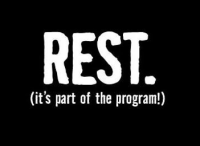Rest-Based Training
A few weeks back, I was at a dinner with a group of coaches and elite runners. Not surprisingly, the topic of training bubbled to the surface. As we tossed around training ideas, we began to discuss our individual mission statements for training. What is the touchstone on which we base our philosophies? What is the foundation to which we return when we find ourselves entangled in the day-to-day grind? The answer was unanimous.
 Rest.
Rest.
If you look at the training load these athletes carry, you would think rest doesn’t even factor into the equation, much less claim a primary focus. But in reality, rest-based running is the key to optimized training.
When we talk about training philosophies, we often talk in terms of pace and distance. Rest is very rarely discussed. Sometimes, rest is even viewed negatively. But rest-based training prioritizes our hard efforts. It focuses on rest and recovery as the key to training. Rest-based running does not mean easy. It means we are including the proper amount of recovery so we can have higher quality training.
Almost all training plans include details on rest, pace, and distance. And each plan tends to revolve around one of those aspects—its center of gravity, so to speak. Pace-based or distance-based plans tend to be too narrow and rigid. They don’t allow flexibility to account for fatigue, illness, injury, or weather. Our bodies, then, are held to hard numbers, whether or not we are physically able to hit those numbers. Fatigue muddles our efforts, and instead of having really easy easy days and really hard hard days, we end up with string of “medium” days. And medium days don’t get you far. They will, however, make you tired. (Rest-based training is therefore harder than pace- or distance-based running. Its easy days are easier and its hard days are harder.)
Science shows that it is during our recovery period that we make gains. Rest does not mean lounging around. It means taking an easy day when our bodies need it. It means listening to our bodies. No, we don’t wait until we feel amazing before we attempt a hard run. But we do focus on what we need to do so that on those hard days, we can perform at our highest level. Because we’re not bound to a specific pace, mileage, or schedule, we can let our bodies lead the way on when to push again. And when we push again, we are recovered enough to push to new levels.
I am a fan of “optimum versus maximum.” The goal of optimum is to do the best we can, not necessarily the most we can. We want to keep quality up for as long as possible. If we go for maximum, we’ll start making accommodations simply to survive the workout. We will start slowing down too soon simply to get through the mileage. In the end, we end up sacrificing quality for quantity. If good is the enemy of great, maximum can be the enemy of optimum. Our goal shouldn’t be to survive, but to get the best training results we can.
We need to stop worrying about hitting a certain total mileage or a specific number of repeats and instead focus on maintaining the proper intensity level for as long as possible. We need to focus on keeping our hard days hard and our easy days easy. By monitoring our intensity levels—and not obsessing over pace and distance—we can improve our performances.
Rest-based running utilizes the optimum code by making sure we do what's best for us to prepare for our tough patches of training and racing. When we train, we want our bodies to tell us when we’re recovered—not the clock or a calendar. And fully recovered doesn’t mean perfect; it does mean that our bodies have recovered enough for the next session. Whether that is the next interval, next run, or next hard workout, our bodies lead the way. In other words, when our bodies are ready to handle the next session, we go.
Because of this rest-and-readiness mentality, rest-based training tends to be tougher and higher in quality than other training planes. It’s like pouring gas on a fire. When you recover, you are filling a bucket with gas to dump on a fire. You want to dump the buck as soon as it’s full. If you dump the bucket too soon, the gas won’t have much of an effect. But if you wait too long, unused gas will spill on the ground. Recovery is akin to being as efficient as possible when pouring gas on the fire.
Elite runners are incredibly in tune with their bodies. They have an uncanny ability to know what's too fast, what's too slow, when they're pushing too much, and when they can dial it up another notch. For most of us, our calibration isn’t as refined. Rest-based running is very much an intensity-focused plan similar to heart rate training. Heart rate training can help us mortal runners get a better sense for intensity levels and let us know when we need more recovery, when we’re ready to go, and so forth.
Rest-based running may sound counter-intuitive. It may even sound “lazy.” But don't let the name fool you. Rest-based training is the best way to improve the quality of your training and take your training and racing to the next level.

Tim Cary is Head Track & Field and Cross Country for Lindenwood University at Belleville and the former Fleet Feet Assistant Training Manager. Over his more than two decades of coaching, Tim has coached athletes to three national team championships, five national individual championships, two national records, and numerous All-American and All-State honors. Click here to receive Tim's weekly article via email.
Connect With Us
see the latest from Fleet Feet St. Louis